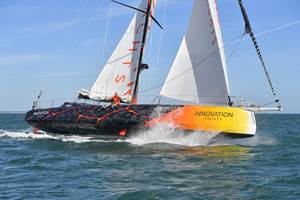Zero-waste, high-performance nonwovens
CAMX 2025: Through a reclaiming and reengineering process, Endeavor Composites creates nonwoven preforms from unused carbon fiber waste, reducing costs and environmental impact while still meeting stringent design requirements.
Share
Source | Endeavor Composites Inc.
(Knoxville, Tenn., U.S.) presents a patented nonwoven fiber technology that enables the production of defect-free, isotropic and multifunctional preforms without the need for binders. These factors result in stronger, more consistent products suitable for demanding applications across automotive, aerospace, industrial, defense, transportation, marine, and sports and leisure sectors.
High-performance nonwoven materials like carbon fiber have historically been cost-prohibitive or waste-intensive. Endeavor Composites aims to eliminate both barriers. The company optimizes manufacturing by reclaiming and reengineering unused, high-quality fiber remnants from fiber producers and recyclers. With its process, virtually zero materials go to landfill, the company reports, reducing costs and environmental impact for manufacturers while opening new revenue opportunities. On a broader scale, Endeavor Composites says its technology has the potential to monetize more than $1 billion annually in otherwise wasted carbon fiber.
Endeavor’s process delivers fabrics with high uniformity and strength, capable of processing fibers with aspect ratios up to 5200 (fiber-dependent). This opens the door to scalable, custom-engineered solutions that meet even stringent design requirements. Whether working with carbon fiber, metal, hemp, banana or other organic fibers, Endeavor collaborates closely with engineering, procurement and design teams to build tailored materials for next-gen applications.
At the core of its mission is application-driven R&D that empowers customers to overcome manufacturing bottlenecks and achieve previously unattainable performance benchmarks, carbon fiber being only the beginning of Endeavor Composites’ future work.
Related Content
-
European boatbuilders lead quest to build recyclable composite boats
Marine industry constituents are looking to take composite use one step further with the production of tough and recyclable recreational boats. Some are using new infusible thermoplastic resins.
-
JEC World 2024 highlights: Glass fiber recycling, biocomposites and more
CW technical editor Hannah Mason discusses trends seen at this year’s JEC World trade show, including sustainability-focused technologies and commitments, the Paris Olympics amongst other topics.
-
Watch: A practical view of sustainability in composites product development
Markus Beer of Forward Engineering addresses definitions of sustainability, how to approach sustainability goals, the role of life cycle analysis (LCA) and social, environmental and governmental driving forces. Watch his “CW Tech Days: Sustainability” presentation.
Related Content
European boatbuilders lead quest to build recyclable composite boats
Marine industry constituents are looking to take composite use one step further with the production of tough and recyclable recreational boats. Some are using new infusible thermoplastic resins.
Read MoreJEC World 2024 highlights: Glass fiber recycling, biocomposites and more
CW technical editor Hannah Mason discusses trends seen at this year’s JEC World trade show, including sustainability-focused technologies and commitments, the Paris Olympics amongst other topics.
Read MoreWatch: A practical view of sustainability in composites product development
Markus Beer of Forward Engineering addresses definitions of sustainability, how to approach sustainability goals, the role of life cycle analysis (LCA) and social, environmental and governmental driving forces. Watch his “CW Tech Days: Sustainability” presentation.
Read MoreAll-recycled, needle-punched nonwoven CFRP slashes carbon footprint of Formula 2 seat
Dallara and Tenowo collaborate to produce a race-ready Formula 2 seat using recycled carbon fiber, reducing CO2 emissions by 97.5% compared to virgin materials.
Read MoreRead Next
Scaling up, optimizing the flax fiber composite camper
Greenlander’s Sherpa RV cab, which is largely constructed from flax fiber/bio-epoxy sandwich panels, nears commercial production readiness and next-generation scale-up.
Read MoreNext-gen fan blades: Hybrid twin RTM, printed sensors, laser shock disassembly
MORPHO project demonstrates blade with 20% faster RTM cure cycle, uses AI-based monitoring for improved maintenance/life cycle management and proves laser shock disassembly for recycling.
Read MoreCutting 100 pounds, certification time for the X-59 nose cone
Swift Engineering used HyperX software to remove 100 pounds from 38-foot graphite/epoxy cored nose cone for X-59 supersonic aircraft.
Read More






